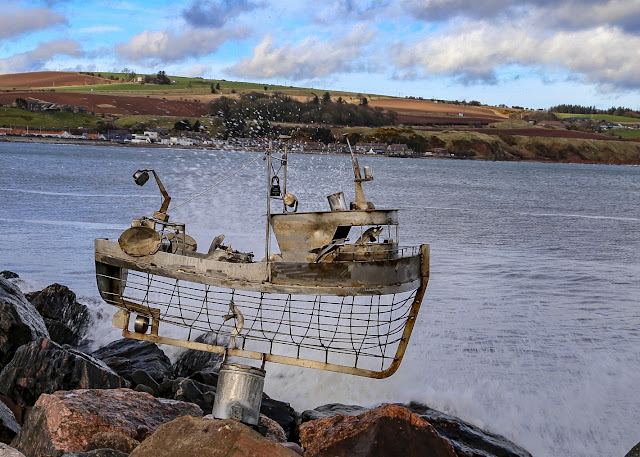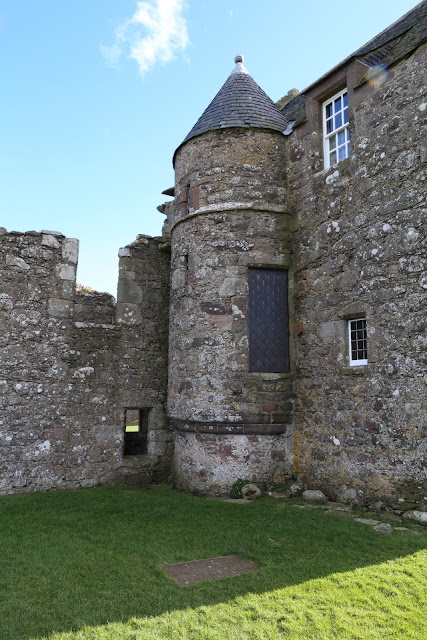Our first trip of 2019 brought with it two new experiences. The first
involved driving through a bad snowstorm that lasted from the south of Glasgow
north to Perth, which as you can imagine was quite stressful. The second was much
more pleasurable. Prior to going away we researched the local campsites to
Stonehaven and discovered that there was one actually on the edge of the town.
Queen Elizabeth Caravan Park belongs to the Caravan and Motorhome Club of which
we were not members so by joining we saved enough money to pay for a yearly membership
which in turn gives us a larger selection of camping sites to choose from.
 |
| Queen Elizabeth Caravan Park. |
The campsite is highly recommended. Well set out, it has very large
pitches that are big enough to accommodate a Caravan with an awning and space
to park you car, so ample space for a Motorhome. Site facilities are
exceptional clean and warm with plenty of hot water. The staffs are friendly
and very helpful.
 |
Stonehaven Harbour.
|
 |
| Various art work along Stonehaven shore. |
 |
| The Old Town House and Clock Tower built in 1790. |
Stonehaven, like many other towns situated on the Scottish coast, was
originally an important centre of the 19th century herring trade whose harbour
was improved in the 1820’s by Robert Stevenson, whose family name often crops
up in our blog. During the 20th century the town changed from a fishing
settlement to a holiday resort boosting a variety of recreational and sporting
facilities.
 |
| The 50m Open Air Swimming Pool. |
One of which is a grand open air 50-metre swimming pool (not open until
the end of May) which was built in 1934 in Art Deco style. An indoor 25-metre
pool is housed within the nearby leisure centre and is open to the public, a
facility we were happy to make use of. Also
within a short walk of the site is a large well-stocked Co-op and further into
town is a variety of smaller shops, restaurants and coffee shops.
 |
| Carron Fish Bar. |
 |
| Now that's what you call an Ice-cream! |
More importantly there are three Fish and Chip takeaways to choose from, with one, the Carron Fish Bar claiming to be the birthplace of the deep-fried Mars bar. Local to the campsite is The Bay Fish and Chips on Beach Road that meant we could bring our fish suppers back to the Motorhome, a little expensive but a grand feast all the same. Also worth a visit is Aunt Betty's Ice Cream and Sweet Shop.
 |
| The Tolbooth Museum. |
 |
| Plenty to see in the museum. |
 |
| The oldest part of town on a rather wet day. |
A walk through Stonehaven along the shore, from just across the road
from the site, will take you to the picturesque cliff bound harbour. An area surrounded
by some of the oldest buildings in the town including the Tollbooth built
around 1600 by Earl Marischal which now doubles as a local history museum.
 |
| Looking down on the Harbour. |
From here you can cut through into Castle Street and then take the
cliff/coastal path that will give you great views down onto the harbour, the
shoreline and across the town.
 |
| Stunning views on the coastal walk to Dunnottar Castle. |
 |
| View from Black Hill back to Stonehaven. |
 |
| Stonehaven War Memorial on Black Hill. |
Continue on the coastal path for some very rewarding views from above
the cliffs. Then onto the Stonehaven War Memorial. Built on the Black Hill, a
beautiful local view point above the town, in 1922 and officially unveiled in
1923 to commemorate the men and women who lost their lives in the First World
War, more names were added after the end of the Second World War. Looking very
different from what you would expect its quite unique, it was designed by a
local architect to look like a ruined temple possibly to signify the ruined
lives of those who’s names are on it but no one knows for sure.
 |
| Dunnottar Castle. |
From here you can make out Dunnottar Castle a highlight of anyone’s
visit to this area. Described as one of Scotland’s most impressive ruined
castle, its location on a rocky headland jutting into the North Sea also makes
it one of the most dramatic. Originally linked to the mainland by a narrow
strip of land which was removed to increase its defences there is however quite
a climb to gain access but well worth the effort.
 |
| The historic ruined castle. |
A missionary station associated with St Ninian first occupied the rock
in the 5th century. It was not until 1390 that the first stone castle was a
built by Sir William Keith and remained in the Keith family, later the Earls Marischal,
until 1716 when the 10th Earl, George Keith, lost his Earldom and forfeited his
estates which included the castle because of his loyal support for James
Frances Edward Stuart and the Jacobite cause. (See further details see Jacobite Connections)
 |
| The Chapel were it said William Wallace attempted to burn 4000 of Edwards English troops. |
Dunnottar Castle has many other links to Scottish history. In 1297
legend has it that William Wallace, during the Wars of Independence and
following Edward 1st of England’s invasion of Scotland, trapped 4000 English
troops in the castles Chapel where they were seeking sanctuary and set a fire
condemning all inside to a terrible death, any who did escape were driven over
the cliff edges - it was said that no one survived.
 |
| View back to land from the castle. |
Mary Queen of Scots stayed at the Castle on two occasions. The first a
few days after the beheading of Sir John son of 4th Earl of Huntley in 1562 and
again in September 1564 when she spent two nights there. It also has links to
Charles 1st and The Honours of Scotland, currently housed in
Edinburgh Castle. When Oliver Cromwell’s Parliamentary Army invaded Scotland he
came after the Scottish Crown Jewels. Crown, sword and sceptre were smuggled
from Edinburgh to Scone Abbey were Charles 2nd was crowned and then onto
Dunnottar Castle. From there they ended up at nearby Kinneff Church where they
remained until 1660. This is only a brief history associated with this
wonderful castle, more can gleamed on your visit from the purchase of the
official guide which is value for money and a very good read.
 |
| Marischal College. |
 |
| King Robert sits guard outside the college. |
 |
| Mercat Cross. |
 |
| The main street via Mercat Cross. |
 |
| Provost Skene's House. |
 |
| Salvation Army Citadel. |
 |
| The old type stamp dispensers. |
 |
| You canny miss with these! |
 |
| Aberdeen sea front. |
 |
| A long promanard with places to sit and enjoy your picnic. |
From Stonehaven there are good bus links to Aberdeen the third largest
city in Scotland known as The Granite City because of the its handsome grey
granite architecture. A very prosperous town that was originally dependent on
fishing and trade until the discovery of oil in the 1970’s. A grand mix of
shops and history plus the Aberdeen beach with its 2-mile promenade, a must on
a bright day and a grand place to relax and enjoy your picnic.
 |
| The RSPB Fowlsheugh. |
 |
| The new viewing shelter. |
 |
| Kittiwake. |
 |
| Mainly Guillemots but if you look carefully you may see a Razorbill? |
 |
| View north from Kincardine Cliffs. |
 |
| View south from Crawton. |
RSPB Fowlsheugh at Crawton is one of the most spectacular bird watching
sites in Britain and is just a 5 miles cycle ride south of Stonehaven, although
on a windy day on the A92 you take your life in your hands. The North Sea
cliffs provide home to upward of 130,000 breeding seabirds including
guillemots, razorbills, kittiwakes, fulmars and the elusive puffins that
unfortunately had not arrived on the day we visited - but were expected any
day! It was here that I wanted to try-out my new long distance lens. Again
because of the very high winds you were unable to get too close to the cliff
edge. A new, rather splendid viewing shelter has been built at end of the well-maintained
footpath and not only offers some grand sea views but also respite from the wind.
 |
| Cowie Church. |
Northwards from Stonehaven is the ruined Cowie Chapel, which can be
reached by walking along the coastal path, and dates back to the 13th
century although it has been a religious site since the 7th century.
Enlarged in the 1500 it fell into disuse in 1560 soon after the Reformation.
Interestingly several Scottish monarchs, in particularly James IV are said to
have worshiped here.
 |
| The Lifeboat Crew. |
 |
| Family grave. |
 |
| 1735 Skull and Crossbones . |
 |
| Cowie Church Cemetery. |
In the graveyard are many fine memorials including one in memory of to
the crew of the Stonehaven lifeboat who drowned on the 27th February
1874 whilst going to the rescue of the Grace Darling.
 |
| Stonehaven Bay and Shore Line.; |
In conclusion I would repeat that the Stonehaven Queen Elizabeth Caravan
Park is one of the best sites we have stayed on and the resort itself is very
clean and tidy and boasts more rubbish bins than we have ever found elsewhere. Plenty
to do and would make a great area to return with our grandchildren during the
their summer holidays, although I would imagine that it would be a lot busier.



























































Thanks for your excellent review of your visit to Stoney. The only thing missing was a mention of those bloomin seagulls-they are so noisy and bold. The reason for the ample bins is so that people won’t leave any food about. We saw a seagull take a full size sausage roll from the wee bakers out a lad’s hand while it was halfway to his mouth. They could double for albatrosses I’m sure. You were braver than us as we were supposed to go last week but the snow put us off-don’t want to write off the new van before it’s even broken in!!
ReplyDelete